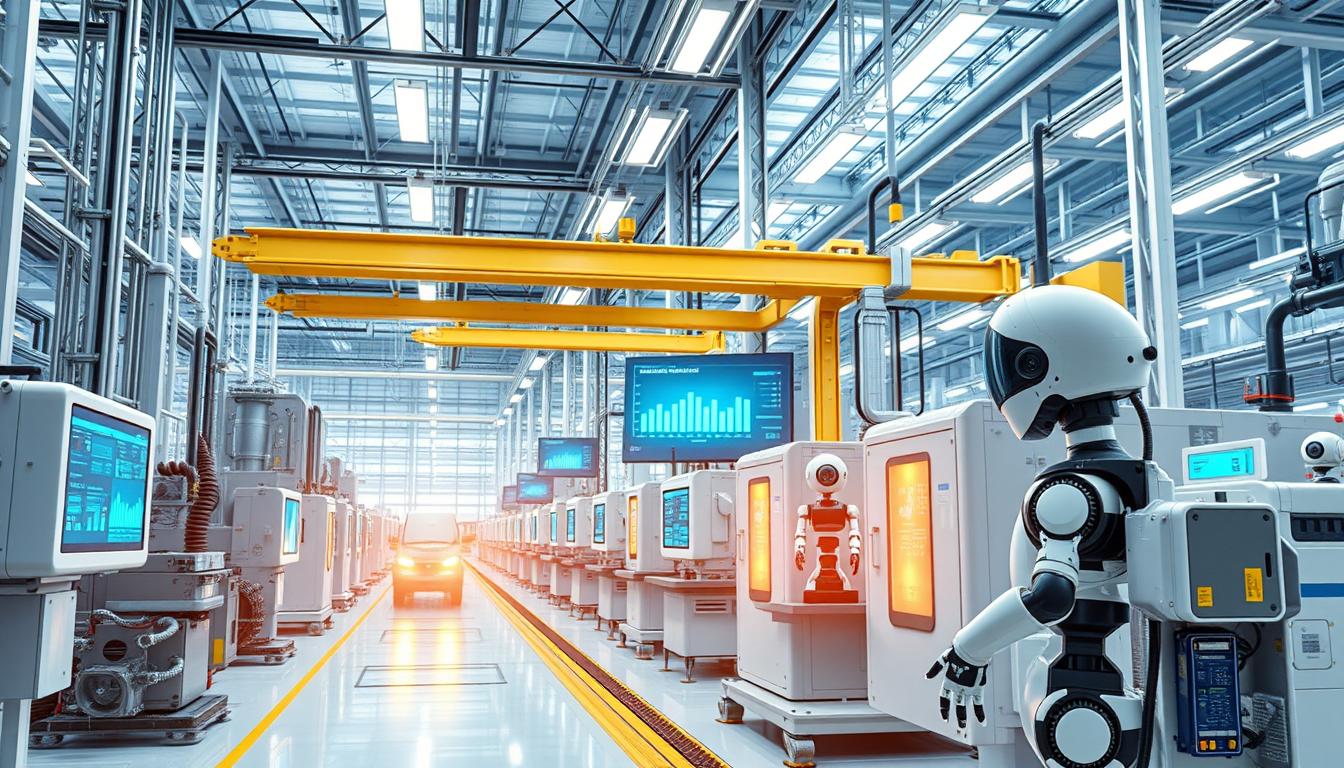Last Updated on December 9, 2025
Welcome to the forefront of industrial technology with Predictive Maintenance. Companies are now focusing more on predictive maintenance than ever before. This shift is driven by the need to optimize industrial operations. Predictive maintenance uses data analysis and advanced technology to foresee equipment problems before they occur. This allows businesses to extend the life of their assets and reduce downtime.
In 2024, we observe major predictive maintenance trends that are transforming the manufacturing sector. These trends empower businesses to stay competitive. The integration of Artificial Intelligence (AI) and the Internet of Things (IoT) enables companies to make informed decisions based on real-time data. This leads to proactive maintenance actions. By grasping these trends, your organization can prepare for the future of predictive maintenance, ensuring smoother operations and improved performance.
Key Takeaways
- Predictive maintenance is revolutionizing how industries maintain equipment and assets.
- AI and IoT technologies are key enablers of effective predictive maintenance strategies.
- Investing in predictive maintenance can significantly reduce operational costs and downtime.
- Immersive technologies enhance visualization for easier equipment inspections.
- Predictive analytics assists organizations in anticipating maintenance needs effectively.
Understanding Predictive Maintenance
Predictive Maintenance (PdM) is a cutting-edge strategy making waves across sectors. It leverages data to forecast and avert equipment breakdowns before they happen. Unlike traditional maintenance, which waits for failures, Predictive Maintenance Technology uses sensor and IoT data to monitor equipment continuously.
The global predictive maintenance market reached $5.5 billion in 2022, a 11% jump from the year before. This surge shows that companies see the worth in Predictive Maintenance Strategies. The market is expected to grow at a 17% compound annual growth rate (CAGR) until 2028.

Industries with large assets, such as oil and gas or mining, are particularly drawn to these methods. For example, unplanned downtime costs in various sectors often exceed $125,000 per hour. This figure underscores the financial benefits of adopting Predictive Maintenance Technology. Early adopters reported a 95% positive ROI, with 27% achieving payback in under a year.
Implementing Predictive Maintenance Strategies can greatly boost operational efficiency. For example, facilities may see
- 5%–10% savings on material costs
- 10%–20% more equipment uptime
- 20%–50% less time spent on maintenance planning
The increasing use of Predictive Maintenance Technology marks a move towards more intelligent operations. This shift not only cuts costs but also enhances health, safety, and environmental standards across industries.
Why Traditional Maintenance Methods Fall Short
Traditional maintenance methods often hinder operational efficiency and lead to significant financial losses. Reactive and time-based preventive strategies dominate many industries, resulting in unexpected downtimes and high maintenance costs. When you consider research indicating that poor maintenance can reduce productive capacity by 5% to 20%, it becomes evident that these methods fall short.
Predictive Maintenance Solutions emerge as a vital response to these challenges. Reports show that implementing a data-driven maintenance approach can reduce overall maintenance costs by 25 to 30 percent. Moreover, organizations leveraging predictive models experience a staggering 70 to 75 percent elimination of equipment breakdowns, translating into substantial savings.
Beyond cost savings, these innovative solutions decrease downtime by 35 to 40 percent. In contrast, traditional maintenance often leads to reactive measures such as emergency repairs that inflate expenses further. A shift to predictive maintenance allows you to take proactive steps, maintaining production levels without the disruptions faced by many who rely on outdated methods.
- Many organizations capture only 30 to 40 percent of their potential data value.
- Over two-thirds of companies in supply chain sectors do not utilize technology for performance monitoring.
- Field engineers are crucial for expediting maintenance processes and identifying system flaws.
In today’s fast-paced world, relying on conventional methods simply isn’t enough. Instead, embracing a data-driven approach can enhance your operational reliability and improve asset lifespan. Adopting tools like Computerized Maintenance Management Systems (CMMS) fosters more efficient maintenance strategies, ensuring you stay ahead in the competitive landscape.
Predictive Maintenance Trends
As industries evolve, a significant shift towards predictive maintenance is observed. Organizations are adopting innovative strategies to improve their operations. Studies have highlighted trends in predictive maintenance, focusing on reducing maintenance costs and transitioning from reactive to predictive models. These changes are leading to increased productivity and enhanced operational safety.
Recent Data on Maintenance Costs
Recent analyses show that predictive maintenance can lower maintenance costs by 5% to 10%. Data from 582 global startups indicates the predictive maintenance market is expected to hit US$ 80,200 million by 2034. The demand is growing at 6.9% in 2023, highlighting the value of predictive approaches. This growth offers companies a chance to improve equipment uptime by 10% to 20%.
Industry Shift from Reactive to Predictive
A major trend is the shift from reactive to predictive maintenance strategies. Leading manufacturing companies are embracing advanced technologies like IoT, artificial intelligence, and predictive analytics. This shift promotes timely maintenance actions and boosts operational efficiency. The integration of software improvements and communication enhancements enables a deeper understanding of equipment health. This leads to a proactive approach, enhancing productivity and sustainability.
How Predictive Maintenance Technology Works
Predictive Maintenance Technology is revolutionizing how companies manage their assets. It uses the Internet of Things (IoT) to collect and analyze data continuously. Advanced algorithms and machine learning provide insights into equipment health, enabling timely maintenance.
Role of IoT and Data Collection
The Internet of Things is crucial in predictive maintenance systems. Industrial IoT sensors monitor vital machine parameters such as:
- Vibration
- Temperature fluctuations
- Wear patterns on parts
This real-time data collection helps detect issues before they cause expensive downtime. Big data technologies improve this process. They handle large volumes of sensor data, maintenance records, and historical information, enhancing operational transparency.
Advanced Analytics in Predictive Maintenance
Predictive Analytics is key to effective predictive maintenance strategies. It analyzes data to spot patterns and correlations, offering insights into equipment performance and potential failures. Advanced AI and machine learning tools automate data analysis, detect anomalies, and aid in decision-making.
Emerging technologies like Digital Twins provide a virtual representation of equipment for real-time monitoring and predictive scenarios. Augmented and virtual reality enhance training and maintenance processes. These technologies lead to a more proactive maintenance approach, improving operational efficiency and reducing costs.
Key Benefits of Predictive Maintenance
Predictive maintenance brings significant advantages to organizations seeking to boost operational efficiency. It enables you to make data-driven decisions, leading to notable improvements in productivity and reliability.
Extending Equipment Lifespan
Predictive maintenance is key in extending equipment lifespan. It uses condition monitoring and real-time data analysis to address issues before they become major failures. Studies indicate that predictive maintenance can increase equipment efficiency by up to 25%. This proactive approach ensures timely interventions, keeping your machinery running smoothly for longer.
Reducing Downtime and Lowering Costs
Reducing downtime is a major benefit of predictive maintenance. Industry studies show a 70-75% reduction in breakdowns with this strategy. As equipment stays operational, your organization avoids costly interruptions and maximizes productivity. These improvements often lead to a 30% reduction in maintenance costs, freeing up budget for other critical areas. Predictive maintenance enhances safety and significantly lowers operational costs.
Challenges in Implementing Predictive Maintenance
Despite its benefits, challenges of predictive maintenance arise during its adoption. It’s essential to grasp these hurdles to achieve success.
Data Management and Integration Issues
Managing data stands out as a major obstacle. Companies must handle vast amounts of data from sensors and IoT devices. This task includes:
- Ensuring data quality and integrity.
- Addressing storage, bandwidth, and computational resource requirements.
- Implementing data validation and cleansing processes.
Integrating with current systems adds complexity. The transition to predictive maintenance technology comes with high initial costs. A strategic approach is needed to manage data management challenges and ensure a seamless integration.
Resistance to Change in Organizations
Resistance to change is a major hurdle in adopting predictive maintenance. Employees may be hesitant to move from traditional maintenance methods. Reasons for this include:
- Fear of job displacement due to new technologies.
- Skepticism about the reliability and usefulness of predictive analytics.
To overcome this, engaging employees through training is crucial. Programs should enhance technical skills and encourage continuous learning. Addressing resistance to change is key to a smoother adoption and greater acceptance of predictive maintenance.
Predictive Maintenance Strategies for Success
Effective Predictive Maintenance Strategies require the selection of tools and technologies that meet your operational goals. The right Predictive Maintenance Tools are crucial for forecasting equipment failures and reducing downtime. By integrating advanced technology, organizations can adopt a more proactive maintenance approach.
Selecting the Right Tools and Technology
To fully benefit from predictive maintenance, investing in the right technology is essential. Key tools include:
- Infrared Thermography for temperature monitoring and identifying equipment issues.
- Vibration Analysis to detect performance issues before they escalate.
- Ultrasonic Acoustic Monitoring which identifies early signs of wear and lubrication problems.
- Oil Analysis for insights into asset health and potential mechanical issues.
- Emissions Testing to evaluate air pollutants and discover underlying problems.
- Partial Discharge Analysis to predict maintenance needs based on electrical spark detection.
These tools provide valuable data and significantly reduce maintenance costs, sometimes by up to 30%. Using these tools can lead to impressive gains in equipment reliability and availability.
Creating a Data-Driven Culture
Fostering a data-driven culture is vital for the success of predictive maintenance initiatives. Empowering your team to collaborate using actionable insights from data analysis is crucial. When employees make informed decisions based on solid data, it boosts productivity and efficiency. A strong data-driven culture can also aid in:
- Reducing the occurrence of breakdowns by up to 70%.
- Extending equipment life by 40%.
- Increasing productivity by as much as 25%.
As organizations adopt these strategies, they can expect to see a 30% increase in equipment reliability. This transformation changes the way operations are managed.

The Future of Predictive Maintenance
The landscape of predictive maintenance is on the cusp of a major transformation, driven by technological advancements. The integration of AI in maintenance is revolutionizing how industries manage equipment. This leads to significant improvements in operational efficiency and safety.
Impact of AI and Machine Learning
Artificial intelligence is poised to transform predictive maintenance, optimizing when interventions occur and cutting unnecessary costs. Businesses stand to gain from:
- Reduced unplanned downtime, ensuring smoother machinery operation.
- Extended lifespan of assets, maximizing return on investment.
- Improved workforce productivity, allowing teams to focus on anticipation rather than reaction.
- Enhanced safety by preventing catastrophic failures, thereby reducing risks to employees.
- Actionable insights that streamline maintenance strategies and enhance operational efficiency.
Potential Expansions Beyond Traditional Industries
Predictive maintenance techniques are expanding beyond traditional sectors, entering various emerging industries. Fields such as:
- Renewable energy, where predictive tools can enhance equipment reliability.
- Smart city infrastructure, optimizing maintenance across interconnected devices.
- Healthcare, ensuring uninterrupted operation of critical medical equipment.
- Telecommunications, improving network reliability by predicting hardware failures.
As AI technology advances, the future of predictive maintenance will include autonomous systems. These systems will predict needs and perform tasks automatically. This vision includes better sensor technology and enhanced data analytics, promising a deeper understanding of equipment conditions.

Real-Life Case Studies of Predictive Maintenance
Predictive maintenance has made a significant impact across various sectors, offering valuable insights into its effectiveness. Real-life case studies highlight the tangible benefits of its implementation. Organizations from different industries have achieved notable success, boosting their operational efficiency and profitability.
Success Stories Across Various Industries
Duke Energy Renewables developed a model analyzing 2.5 years of data. It uncovered 12 errors in wind turbine contactors before they failed. They estimated saving hundreds of thousands of dollars per event by catching generator failures early.
The Global Mining Company, using Uptake software, gets alerts up to a month in advance on maintenance issues. This early warning reduces unscheduled maintenance by about 50 percent, saving around $34 million over five years.
Rolls-Royce uses AI to analyze jet engine sensor data, predicting potential issues for safety. Siemens upgraded its predictive maintenance solution with Generative AI, enhancing user experience and maintenance speed. GE Aviation’s Predix Platform applies AI and machine learning to anticipate maintenance needs, leading to cost savings and optimized operations.
Measurable Improvements in Operational Efficiency
Success stories show a significant move towards predictive maintenance, leading to measurable improvements in operational efficiency. By adopting predictive maintenance strategies, these organizations reduce downtime and enhance equipment reliability. This strengthens their overall operational framework.
Conclusion
The Future of Predictive Maintenance is transforming how industries manage their assets. By adopting predictive maintenance, businesses can cut down on unplanned downtime and maintenance costs. This approach also extends the life of critical equipment. Advanced technologies like AI, machine learning, and IoT are key to this shift, fostering a culture of proactive maintenance.
The advantages of predictive maintenance are clear, from increased productivity to significant cost savings. Companies that embrace this technology see a 75% drop in unexpected breakdowns and a 25% to 30% reduction in maintenance costs. This shows that proactive maintenance is not just a trend but the future of industrial operations.
As technology advances, the potential for predictive maintenance solutions grows. Industries can use Asset Performance Management to improve asset performance and boost operational efficiency. The future is clear: embracing predictive maintenance now will give you a competitive edge in a rapidly changing market.








